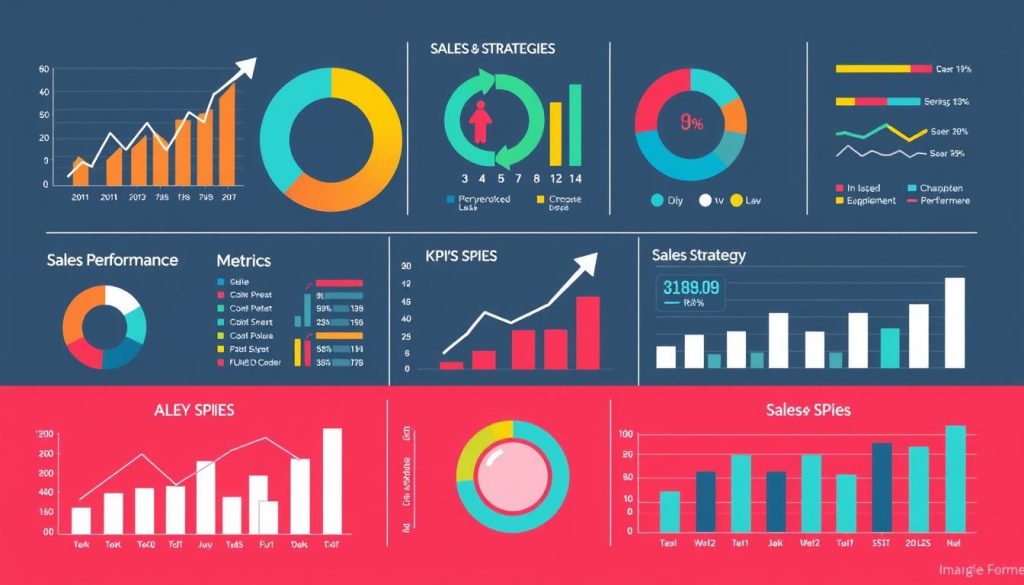Consistent sales growth is vital for businesses of all sizes. Data-driven insights are key to sustainable success. This guide explores sales performance analysis, providing tools to optimize strategies and boost revenue.
Understanding sales performance analysis is crucial for leaders and entrepreneurs alike. It helps you make informed decisions and identify areas for improvement. With these insights, you can empower your sales team to achieve more.
Key Takeaways
- Discover the key components of sales analysis and why it’s crucial for business growth
- Explore essential sales performance metrics and KPIs to track and measure success
- Learn a step-by-step guide to analyzing sales performance, including data collection, cleaning, and analysis
- Understand the importance of sales pipeline management and effective reporting systems
- Gain insights into sales team productivity, forecasting methods, and customer behavior analysis
- Leverage advanced sales analytics tools and technologies for deeper insights
- Optimize your sales strategies through competitive analysis and market positioning
Understanding the Fundamentals of Sales Analysis
Sales analysis is vital for business growth. It examines key metrics to uncover valuable insights. These insights inform strategic decision-making and optimize sales strategies.
By understanding sales analysis, businesses can enhance their overall performance. This process helps companies identify areas for improvement. It also reveals opportunities for increasing revenue and market share.
Key Components of Sales Analysis
Sales analysis involves tracking several important metrics. These include sales figures, conversion rates, and customer behavior. Identifying top-performing products or services is also crucial.
These metrics offer a full view of a company’s sales landscape. They enable data-driven decisions that can boost revenue. Such insights help businesses stay competitive in their markets.
Why Sales Analysis Matters for Business Growth
Sales analysis drives business growth through data-driven insights. It helps companies allocate resources more efficiently. This approach also aids in developing targeted marketing campaigns.
Understanding performance metrics refines sales strategies. Organizations can make informed decisions for sustainable growth. This leads to long-term success and improved market position.
Basic Terms and Concepts
To understand sales analysis, knowing key terms is essential. These concepts form the foundation of effective analysis.
- Lead generation
- Sales funnel
- Conversion rate
- Average order value
- Customer lifetime value
Mastering these terms empowers businesses to interpret sales data effectively. It enables better decision-making and drives sales analysis basics. This knowledge is crucial for overall business growth.
“Sales analysis is the backbone of any successful business strategy. It provides the insights necessary to make informed decisions and achieve sustainable growth.”
Essential Sales Performance Metrics and KPIs
Tracking the right sales KPIs is vital for business growth. These metrics offer insights into your sales processes. They help you spot areas that need improvement.
Let’s look at some key sales metrics. These can help you measure and boost your sales performance.
Top Sales KPIs to Monitor
- Sales Revenue – The total amount of money your business has generated from sales.
- Sales Quota Attainment – The percentage of your sales team’s quota that has been achieved.
- Lead Conversion Rate – The percentage of leads that have been converted into paying customers.
- Average Deal Size – The average monetary value of each sale or transaction.
- Sales Cycle Length – The average time it takes to close a sale, from the initial contact to the final purchase.
- Customer Acquisition Cost (CAC) – The total cost of acquiring a new customer.
These KPIs give you a clear picture of your sales performance. They help you make smart choices to improve your sales strategies.
Leveraging Sales Performance Metrics
Beyond KPIs, other sales metrics can offer valuable insights. These include:
- Sales Pipeline Velocity – The rate at which leads move through your sales pipeline.
- Customer Retention Rate – The percentage of customers who continue to do business with your company.
- Sales Activity Metrics – Measures of your sales team’s activity, such as the number of calls made, emails sent, or meetings held.
- Sales Productivity Metrics – Metrics that assess the overall productivity and efficiency of your sales team.
These metrics help you find ways to improve. They can boost your sales processes and drive business growth.
| Sales KPI | Definition | Importance |
|---|---|---|
| Sales Revenue | The total amount of money generated from sales | Indicates the overall health and success of your sales efforts |
| Sales Quota Attainment | The percentage of a sales team’s quota that has been achieved | Measures the performance and effectiveness of your sales team |
| Lead Conversion Rate | The percentage of leads that have been converted into paying customers | Helps identify the efficiency of your sales funnel and lead nurturing process |

Focus on metrics that align with your business goals. Regular monitoring of these KPIs is key. It drives improvement and leads to lasting sales growth.
How to Analyse Sales Performance: Step-by-Step Guide
Sales performance analysis helps businesses understand their market position and identify growth opportunities. This guide will help you analyze your sales data and gain valuable insights.
Data Collection Methods
Gathering comprehensive information is key to sales analysis. Use various methods to collect data.
- Point-of-sale (POS) systems
- Customer relationship management (CRM) software
- Online sales platforms and e-commerce analytics
- Sales team activity reports
- Market research and industry data
Data Cleaning and Preparation
Clean and organize your data before analysis. This ensures accurate results.
- Identifying and addressing missing or inaccurate data
- Standardizing data formats and units
- Categorizing and segmenting your data for targeted analysis
- Merging data from various sources into a unified dataset
Analysis Tools and Software
Use sales data analysis tools to uncover actionable insights. These tools can streamline your efforts and improve results.
| Tool/Software | Key Features |
|---|---|
| Microsoft Excel | Spreadsheet-based analysis, pivot tables, and data visualization |
| Tableau | Intuitive data visualization and interactive dashboards |
| Google Analytics | Web-based analytics for e-commerce and online sales |
| Salesforce | CRM-integrated sales analytics and forecasting |
This guide will help you analyze sales data effectively. You’ll be able to spot trends and make smart choices for your business.
Sales Pipeline Management and Analysis
Effective sales pipeline management drives business growth. It helps identify areas for improvement and optimize conversion rates. Analyzing your pipeline allows for accurate forecasting of future sales performance.
Let’s explore strategies and best practices for managing and analyzing your sales pipeline.
Optimize Your Sales Pipeline
Map out your sales process and define each pipeline stage. This helps identify bottlenecks and streamline your workflow. It ensures a consistent sales experience for customers.
Regularly review and refine your pipeline. Keep it aligned with your business goals and customer needs.
Improve Conversion Rates
Analyze pipeline data to understand where prospects drop off and why. Look for ways to enhance your sales process. This could include improving lead qualification or personalizing outreach.
Address pain points to increase conversion rates. Better customer support can help close more deals.
Accurate Sales Forecasting
Use pipeline data to develop more accurate sales forecasts. Track key metrics like lead-to-opportunity conversion rates and deal size. Monitor sales cycle length to predict future revenue.
This information helps make informed decisions. It allows for effective resource allocation and setting realistic sales targets.
| Metric | Description | Impact on Sales Pipeline |
|---|---|---|
| Lead-to-Opportunity Conversion Rate | The percentage of leads that are converted into sales opportunities. | Helps identify the effectiveness of your lead qualification process and opportunities for improvement. |
| Deal Size | The average monetary value of each deal closed. | Provides insights into the potential revenue and profitability of your pipeline. |
| Sales Cycle Length | The time it takes to move a prospect from lead to closed deal. | Enables better sales planning, resource allocation, and forecasting. |
Mastering pipeline management and analysis drives business growth. It improves sales performance and keeps you ahead of competitors. Regular review and optimization help make data-driven decisions.

Implementing Effective Sales Reporting Systems
Sales reporting is vital for business growth and informed decision-making. It can transform how organizations analyze sales. Actionable reports, strong feedback loops, and automation tools are key elements.
Creating Actionable Reports
Effective sales reporting starts with insightful, data-driven reports. These should offer more than raw data. They should provide actionable insights for sales teams.
Good reports help identify trends and optimize strategies. They focus on key sales metrics and align with business goals. This ensures real value from sales reporting.
Report Distribution and Feedback Loops
Distributing reports to the right people is crucial. This includes executives and frontline sales reps. It gives decision-makers the info they need to drive progress.
Feedback loops are also important. They help refine reporting systems over time. Organizations can incorporate user input and adapt to changing business needs.
Automation Tools for Reporting
Automation tools can streamline the sales reporting process. They handle data collection, analysis, and report generation. This frees up time for sales teams to focus on strategy.
These tools reduce effort in creating comprehensive reports. They enhance sales performance and decision-making capabilities. Embracing automation leads to greater efficiency in sales reporting.
| Feature | Benefit |
|---|---|
| Automated Data Aggregation | Consolidates data from multiple sources, reducing manual effort |
| Customizable Report Templates | Enables the creation of tailored, visually appealing reports |
| Scheduled Report Delivery | Ensures timely distribution of sales reporting to stakeholders |
| Real-Time Analytics and Dashboards | Provides instant visibility into sales performance and trends |
“Effective sales reporting is the cornerstone of data-driven decision-making, empowering businesses to optimize their strategies, capitalize on emerging opportunities, and drive sustainable growth.”
Sales Territory Optimization Techniques
Optimizing sales territories is key for business growth. It involves analyzing sales data and customer demographics. By dividing your market into manageable areas, you can boost sales and improve customer satisfaction.
This strategy allows for efficient resource allocation. It also enhances responsiveness and enables targeted service.
Here are some key techniques for sales territory optimization:
- Geographic Segmentation: Divide territories based on location factors. Consider population density, transportation routes, and natural boundaries. This balances workloads and reduces travel time for your team.
- Account Clustering: Group customers by purchase patterns or industry. This helps tailor sales strategies and provide personalized service to each segment.
- Potential Revenue Estimation: Analyze sales data and market trends. Estimate revenue for each territory. This helps allocate resources and identify high-growth areas.
- Workload Balancing: Review and adjust territory management regularly. Ensure even distribution of workloads. This prevents burnout and maintains optimal productivity.
- Continuous Monitoring and Adjustment: Track sales performance metrics often. Make territory adjustments as needed. This helps adapt to market changes and seize new opportunities.
These techniques can unlock your sales force’s full potential. They drive sustainable business growth by aligning resources with customer needs.

“Effective sales territory management is the cornerstone of a successful sales strategy. By aligning your resources with your customers’ needs, you can maximize productivity and profitability.”
Measuring Sales Team Productivity
Sales team productivity is vital for business growth. Key metrics help organizations gain insights into their sales operations. These insights can identify areas for improvement.
Individual Performance Metrics
Assessing individual sales reps involves tracking crucial metrics. These include sales productivity, conversion rates, and average deal size. These metrics show each team member’s performance clearly.
Managers can use this data to identify top performers. They can also address skill gaps and implement targeted training programs.
Team Collaboration Assessment
Sales teams thrive on effective collaboration. Team performance evaluation is key to understanding team dynamics. Factors like communication and knowledge-sharing can be analyzed.
This analysis can reveal areas to enhance team collaboration. Improved collaboration leads to better sales metrics and overall productivity.
Training Impact Analysis
Investing in sales team training is strategic. Measuring the impact of these initiatives is equally important. Organizations can analyze performance changes before and after training.
This analysis helps determine training program effectiveness. It also informs decisions about future investments in sales development.
| Metric | Description | Importance |
|---|---|---|
| Sales Productivity | The ratio of revenue generated to the time and resources invested by sales representatives. | Measures the efficiency and effectiveness of individual sales representatives. |
| Conversion Rate | The percentage of leads that are converted into paying customers. | Indicates the effectiveness of the sales team in converting opportunities into sales. |
| Average Deal Size | The average value of each sale completed by the sales team. | Reflects the team’s ability to close larger deals and generate higher revenue. |
Monitoring sales productivity, team performance evaluation, and sales metrics is crucial. It helps organizations make informed decisions. It also optimizes sales processes and drives sustained growth.
Sales Forecasting Methods and Best Practices
Accurate sales forecasting is crucial for business success. It helps companies make smart decisions and improve sales strategies. Historical data and market trends provide valuable insights for predicting future sales performance.
Linear regression analysis is a popular sales forecasting method. It examines how factors like economic indicators affect sales. Time series analysis focuses on patterns in past sales data to predict future sales.
The moving average and exponential smoothing techniques smooth out sales fluctuations. These methods provide more accurate predictions for sales forecasting.
Predictive analysis tools use machine learning and AI to analyze complex data. They can identify hidden patterns that affect sales performance.
Regularly review and adjust sales performance forecasts. Consider changing market conditions and customer behavior. This helps keep predictions accurate and relevant.
Businesses can improve their sales forecasting by using these methods. Better forecasts lead to smarter decisions and sustainable growth.
“Accurate sales forecasting is the foundation of strategic business planning and decision-making.” – Jane Doe, Sales Analyst

Customer Behavior Analysis in Sales Performance
Understanding customer behavior is vital for improving sales performance. It provides valuable insights that drive strategic decisions and boost revenue. Purchase pattern recognition and customer segmentation are two key aspects of this analysis.
Purchase Pattern Recognition
Analyzing customer purchase patterns is a powerful sales performance tool. It helps businesses anticipate customer needs and preferences. This knowledge can improve marketing campaigns, product development, and inventory management.
Customer Segmentation Strategies
Effective customer segmentation is crucial for successful customer behavior analysis. It involves grouping customers based on shared traits like demographics or buying habits. This approach allows for personalized interactions and higher conversion rates.
Lifetime Value Assessment
Assessing customer lifetime value is essential in sales data analysis. It helps sales teams prioritize efforts and allocate resources effectively. Understanding long-term customer value drives informed decisions for sustainable growth.
| Metric | Description | Importance |
|---|---|---|
| Customer Lifetime Value (CLV) | The estimated net profit a business can expect from a customer over the entirety of their relationship. | Helps prioritize high-value customers, identify opportunities for upselling and cross-selling, and guide customer retention strategies. |
| Customer Acquisition Cost (CAC) | The total cost of acquiring a new customer, including marketing, sales, and onboarding expenses. | Enables a better understanding of the profitability of customer relationships and guides decisions on marketing and sales investments. |
| Churn Rate | The percentage of customers who discontinue their relationship with a business over a given period. | Highlights areas for improvement in customer satisfaction and retention, informing strategies to reduce churn and maintain a loyal customer base. |
Customer behavior analysis empowers sales teams to make data-driven decisions. It optimizes sales performance, enhances customer engagement, and drives long-term business growth.
Competitive Analysis and Market Positioning
Success in sales relies on knowing your competitors and market position. These tools help refine strategies and boost performance. They’re key to staying ahead in the ever-changing sales world.
Competitive analysis involves studying your rivals’ products, pricing, and marketing tactics. This information helps you spot their strengths and weaknesses. You can then use these insights to improve your sales approach.
- Identify your key competitors: Start by creating a list of the businesses that offer similar products or services to your target audience.
- Gather competitive intelligence: Collect data on your competitors’ pricing, product features, marketing campaigns, and sales performance.
- Analyze the data: Identify patterns, trends, and opportunities that can help you differentiate your offering and improve your sales performance.
Market positioning creates your brand’s unique identity in the marketplace. It involves understanding your audience’s needs and preferences. This knowledge helps you position your products effectively and gain an edge.
| Metric | Company A | Company B | Company C |
|---|---|---|---|
| Market Share | 25% | 18% | 12% |
| Average Sales Growth (YoY) | 8% | 5% | 3% |
| Customer Satisfaction Rating | 4.8/5 | 4.2/5 | 3.9/5 |
Combining these tools gives businesses a clearer view of their competitive landscape. It helps create sales strategies that connect with target audiences. This approach can boost sales performance and foster long-term growth.
Advanced Sales Analytics Tools and Technologies
Sales analytics tools have revolutionized the industry. These tools include AI, machine learning, predictive analytics, and data visualization platforms. They enhance analysis capabilities and improve decision-making processes for sales teams.
AI and Machine Learning Applications
AI and machine learning offer valuable insights for sales analytics. They identify patterns, forecast trends, and personalize customer interactions. These technologies help sales teams make informed decisions and streamline their work.
Predictive Analytics Solutions
Predictive analytics use historical data to forecast future sales performance. They help anticipate customer behavior and optimize sales strategies. These tools can drive sustained growth for your organization.
Data Visualization Platforms
Data visualization is crucial for unlocking sales analytics potential. Modern platforms offer intuitive dashboards and interactive charts. These features help teams understand complex data and derive actionable insights.




